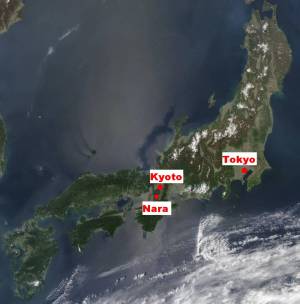
|
CrawlTrack, webmaster dashboard.
Web analytic and SEO CrawlProtect, your website safety. Protection against hacking, spam and content theft Two php/MySQL scripts, free and easy to install
The tools you need to manage and keep control of your site. |

|
Web analytic and SEO
CrawlProtect, your website safety.
Protection against hacking, spam and content theft
Two php/MySQL scripts, free and easy to install
CrawlTrack blog
Two weeks in japan
In April 2008, I have spent two weeks in Japan with my 15 years old daughter. We spent one week in Tokyo, then we comute to Kyoto in Shinkansen to spend the second week there. This site will enable you to share our travel, our discoveries, our astonishments. Japan is really a country of contrasts and I hope that by discovering these photographs you will have only one desire, to go there you too.
History
Capitals of JapanJapan capital is today Tokyo, a 13 millions inhabitants city (more than 30 millions with the suburb), but that was not always the case. During our travel we have visited the 3 towns which were successively capital of Japan. To begin Nara, which became capital of the Kingdom at the time of its foundation in 710 by Genmei empress. At that time the name of Nara was Heijo-Kyo. In 794 the emperor wanted to move away from the Buddhist influences and thus moved the capital to Heiankyo (literally capital of peace). The city will quickly be renamed Kyoto (literally capital city). When in 1185 Minamoto no Yoritomo has taken capacity from the emperor and founded the military dictatorship known under the name of Shogunat, he kept Kyoto as capital. This long period of reign of Shoguns and Samourais taken end in 1868 at the time of the Meiji restoration. The emperor then retrieved the political power. It was the time for a new change of capital which was transferred to Edo which taken then the name of Tokyo (literally eastern capital). 
Our travelHere is course of our travel day per day, the goal is not to give a model to be followed but that will enable you to see what is possible to see in two weeks. The days were sometimes very charged, we walk a lot but we also succeeded to have some rest from time to time.Saturday April 19, 2008 Takeoff of Toulouse (France) about midday for a stopover in Munich and then a flight towards Tokyo Narita. Sunday April 20, 2008 Arrived at Tokyo around 10 a.m., transfer in bus + taxi towards our hotel. A small round in the surroundings of the hotel and a large nap to recover from the flight. Monday April 21, 2008 Discovered and training of the operation of the subway. Visit Harajuku district. Tuesday April 22, 2008 Akihabara Direction, then Ueno where we visited the zoo and the Shitamachi museum. Return while passing by the Ameyoko market. Wednesday April 23, 2008 Visits district Asakusa, a small round in a rickshaw. At the end of the afternoon we took the direction of Western Shinjuku to visit the town hall. Thursday April 24, 2008 Visits Higashi park followed in the afternoon by a long moment in the museum of sciences of Tokyo. Friday April 25, 2008 Shimbashi District with visit of the tower Dentsu (point of view at the top + museum of publicity), visit of the park Hama Rikyu and a small round by the fish market. Then we go for shopping in Shibuya district. Saturday April 26, 2008 Travels in Shinkansen towards Kyoto, play of track to find our Ryokan (thank you with the kindness for Japanese). And an afternoon of relaxation to evacuate the tiredness of this first week. Sunday April 27, 2008 Visits of Kyoto with a French-speaking guide, day marathon with the visit of Kinkaku-ji, Ryon-ji and its Zen garden, of the castle Nijo, a manufacture of kimonos, Sanjusangendo and finally of Kiyomizu-dera. Monday April 28, 2008 Visits of Gion, geisha's district. We assisted to the show Miyako Odori at the district of Gion theatre. Tuesday April 29, 2008 Long walk on the path of philosophy. Wednesday April 30, 2008 Second day with a French-speaking guide, this time we travelled by train in direction of Nara. Visit in Nara of the Todai-ji, a small round by the primitive forest, visits of a 8 century old house, a visit of the town centre and to finish visit of the national museum. Thursday May 1, 2008 Visits of the Kyoto train station, followed by a time in the Nishiki market and then end of day in the international manga museum of Kyoto. Friday May 2, 2008 Visits Shosei garden, then a long moment in Tofuku-ji and finally all the afternoon in Kyoto Park Studio. One day a little apart from the path beaten, we have seen very few foreign tourists. Saturday May 2, 2008 Wake up at 5 a.m. to take our train in direction of Osaka airport. Arrival in Toulouse about midnight after a stopover in Frankfurt. |
Tokyo
AkihabaraAkihabara, district known universally by Geek. This is the kingdom of technology and electronics. You will find department stores with more than 6 levels but also shop of less than 2 square meters. AsakusaAsakusa is the heart of traditional Tokyo, some say you can found here the spirit of old Edo (old name of Tokyo). This' is a very tourist district and more particularly the Senso-Ji temple and the street Nakamise Dori which carries out to it. HarajukuThe district of Harajuku is known by the youths of Tokyo to be the place where to go to have up-to-date dress. A little bit later, and a little bit richer they will go rather towards the street Omotesando, street of the great creators. HigashiThe Higashi park is in fact the park of the imperial palace. The palace which is always inhabited by the imperial family cannot be visited, but the park is in free access and as you will see it there is really splendid points of view. UenoUeno, or the plain with the cherry trees. The Japanese cherry tree is very important here, and for the period of flowering much Japanese come to admire them in Ueno. The season being particularly early this year, we were unable to see them as it was too late. We visit the Zoo of Ueno and the Shitamachi museum. This small museum shows Tokyo in the past. ShibuyaShibuya is a very animated district, it's the dreamed place for who wants to make shopping. You will find the last tendencies of the mode there, the young people of Tokyo more particularly appreciate Shibuya 109 which shelters a hundred shops. The station of Shibuya is one of the most important of Tokyo. ShimbashiBusinesses district, there is here a lot of skyscrapers, the fish market of Tokyo and the park Hama Rikyu. The Dentsu tower will offer us a beautiful point of view on the surroundings. Town hallThe town hall of Tokyo is in the Western Shinjuku district. It's a skyscraper with two 243 height meters towers (48 stages) whose construction was completed in 1990. The visit it free and we can go up to a panoramic observatory located at 200 meters in height. We benefitted from this opportunity and taken some photographs. Kyoto
Kyoto train stationKyoto attracts many tourists with its many temples, but the more visited site in the city surprisingly is an ultramodern building. It's the train station, built in 1997 by the architect Hiroshi Hara. It's a true city in the city with a hotel, a department store, many shops and restaurants. Each day, it's more than 240.000 peoples who used that station. Kinkaku-jiKinkaku-ji is more known under the name of gold temple. It is cover with fine gold on all its upper part. It's obviously impossible to visit Kyoto without going to see this temple. Kiyomizu-deraKiyomizu-dera is a Buddhist set of temples, the most known is equipped with a platform which is 13 meters above neighbouring forest and which offers a beautiful sight seing on Kyoto. The origin of these temples goes back to the 8th centuries, but the buildings still existing today go back to 1633. Kyoto Studio ParkKyoto Studio Park is a park which belongs to the company Toei Kyoto Studio, the largest movie studio and of television of Japan. We can walks in the middle of film set which are used for more than 200 dramas per annum, and also many films of cinema. Nijo castleThe Nijo castle was built by Shogun Tokugawa Leyasu in 1603. It was used as second home for the shogun at the time of their passage in Kyoto. It's here that the shogun Yoshinobu Tokugawa gave back political power to the emperor in 1867, putting an end to almost 7 centuries of shogunat. Nishiki marketThe Nishiki market is in the center of Kyoto. You can finds all the ingredients of the Japanese kitchen there. It's all the contrast of this ultramodern country so traditional in the same time. This market is a treat for the eyes full of surprise for us. Nishijin Textile CenterNishijin Textile Center is a manufacture of kimonos installed in the center of Kyoto since the 19th century. It's mainly a hall of exposure and sale, but that also makes it possible to see craftsmen at work. The techniques of weaving used are traditional techniques with the hand but also with the helps of weaving looms Jacquard.These weaving looms were imported in Japan in 1873. If you want to buy a kimono, it's really a good address, but attention for a true silk kimono it is necessary to envisage a consequent budget. Path of philosophyThe path of philosophy is a pleasant walk which skirts a small channel at the beginning of Ginkaku Ji also known under the name of silver temple. This way will carry out us in the suburbs of Kyoto along the hill and we will pass in front of a lot of remarkable temples, such as Nazen Ji and Zenrin Ji. Shosei-enThe Shosei-en garden was created at the 9th century by prince Minamoto Notooru. The drawing of the current garden goes back to 1643, when the park was redrawn by Ishiyama Saijo. Its goal was to give vision as much different from nature that it is possible in a small place. Tofuku-jiThe Tofuku-ji temple, not in the traditional tourist tours in Kyoto, is the seat of the Tofukuji school of the Rizai sect of the zen Buddhism. The temple was built in 1236, it suffered from destruction several times. The visible buildings today date for some from the 14th centuries but much are much more recent. Nara
Kasuga-taishaWhile passing by the forest, we pass in front of innumerable stone lanterns. We then arrived at the sanctuary shintoïste Kasuga-taisha, painted in orange which slices with the green of the forest. This sanctuary goes back to 701, but in accordance with the rites of Shinto purification it was demolished and rebuilt every 20 years untill 1863, date on which this cycle of destruction-rebuilding was stopped. SangatsudoThis set of Buddhist temples is located on the heights of Nara. It's a striking example of the interpenetration of the two Japanese religions, Buddhism and shintoism. You will finds shinto sanctuaries between the Buddhist temples. From its position in height, Sangatsudo offers a beautiful sight seing on Nara. Todai-jiTodai-ji is the Buddhist temple most known of Nara. It shelters in Daibutsuden (greatest timber construction of the world) a statue of Buddha of 15 meters height. Another characteristic of Nara is the presence of deer in freedom.
|





















